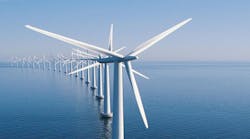With state officials eyeing $56 billion of wind farm projects off the American coastline, developers are worried the turbines will need to be stamped with a big "Made in the U.S.A."
Each structure is enormous -- almost half the height of the Empire State Building. Most all of them are constructed in Europe, at least for now. As states in the U.S. Northeast jump into wind power, they’re betting they can create their own windmill industry. It’ll be a costly but perhaps necessary move, especially as President Donald Trump pushes for more factory jobs and picks fights with those making parts abroad.
“There’s no way of hiding that every single state, be it here in the U.S. or be it countries in Europe, are insisting on everything sort of being local,” said Henrik Poulsen, CEO of Orsted A/S, the Danish company that is the world’s largest offshore-wind developer. “It is an equation that’s very difficult to solve without the whole technology becoming much more expensive.”
Initially, the cost of offshore wind farms will be 45% more than those built in Europe, partly because much of the equipment will have to be imported, according to Bloomberg New Energy Finance. The viability of any new projects will require long-term supply agreements that guarantee developers can sell their power at above-market rates, BNEF said.
Going Offshore
Windmills aren’t new for Americans, who get more electricity from the structures than any country except China, which is investing heavily. But almost all the capacity is on land and use smaller turbines than those at sea. Building 15 miles or more offshore is appealing because breezes are stronger and more uniform, and there are no neighbors to oppose structures with rotors that at their highest are almost 600 feet above the surface of the ocean.
Massachusetts, New York, New Jersey and Maryland have proposed offshore projects primarily to meet targets for reduced pollution from fossil-fuel power plants. The states are willing to offer incentives they hope will expand supplies of renewable electricity and help spur local job growth.
Eventually, the cost of building offshore should fall, especially if domestic manufacturing takes off. In Europe, where government support helped fund offshore windmills and a domestic manufacturing industry over two decades, offshore capacity for producing electricity almost quadrupled from 2010 to 2016. Some new wind projects at sea are now cheaper than building a natural-gas or coal plant on land, according to Orsted’s Poulsen.
Cheaper Energy
The cost of building some of the biggest offshore wind projects in Europe has been cut by more than half in the past decade, though they remain more expensive to build than solar-power and onshore-wind plants, according to BNEF.
“The critical mass in the U.S. is not there yet,” said Adam Thomsen, head of U.S. market entry for MHI Vestas Offshore Wind A/S, a Denmark-based joint venture between Mitsubishi Heavy Industries Ltd. and Vestas Wind Systems A/S that wants to expand into the American market. “We believe in the long-term potential.”
The federal government has issued 14 offshore leases, and four states -- Massachusetts, New York, New Jersey and Maryland -- are targeting a combined addition of almost 8 gigawatts of electricity from offshore windmills by 2030. Massachusetts is already fielding bids from European developers including Orsted, as well as some domestic companies like Deepwater Wind LLC, which built a small project off the coast of Rhode Island in December 2016.
Kickstart Industry
Even if only half the proposed wind farms are developed in the next 12 years, that could generate enough demand to kickstart domestic manufacturing industries to support more than 25,000 new jobs, according to a study prepared for New York, Massachusetts and Rhode Island by BVG Associates Ltd.
“We’re doing this to attract private investment” that could make New York a “hub for the offshore industry in the U.S.,” said Alicia Barton, president of the agency that promotes renewable energy use. New York plans to build 2.4 gigawatts of offshore wind by 2030, and last month initiated a process to procure the first 800 megawatts.
Still, getting those projects built and a domestic manufacturing industry off the ground will depend on “how much the ratepayers are willing to stomach in cost increase” and “how quickly the costs can come down,” said Amy Grace, a New York-based analyst for Bloomberg New Energy Finance.
The first indication of how far states are willing to go with incentives could come in Massachusetts, which aims to install 1.6 gigawatts of offshore wind by 2027. On April 23, the state will announce the results of bids by developers that could lead to the region’s first power-purchase agreement, said Bill White, senior director for offshore wind at the Massachusetts Clean Energy Center.
Startup Costs
The Massachusetts project could come in at $100 to $120 a megawatt-hour, according to Tom Harries, wind analyst at Bloomberg New Energy Finance. That compares with $49 for a new natural-gas plant and $66 for a new coal plant.
Competition among the states could undermine efforts to create regional industries similar to those in Europe. Maryland requires that projects it approves add jobs and investment in the states. New York will spend $15 million to train workers and upgrade ports. New Jersey’s new governor, Phil Murphy, issued an executive order last month that sets the state on a path to create 3.5 gigawatts of offshore power by 2030.
States probably will “fight tooth and nail to get the crown jewels of this industry,” said Stephanie McClellan, director of the University of Delaware Special Initiative on Offshore Wind.
“Ideally, to bring costs down, you want a collective approach,” said Harries, the BNEF analyst. “What you don’t want is almost state protectionism where somebody says, ‘We want to keep all the jobs here. We want to do it all ourselves.”
By Jim Efstathiou Jr.





